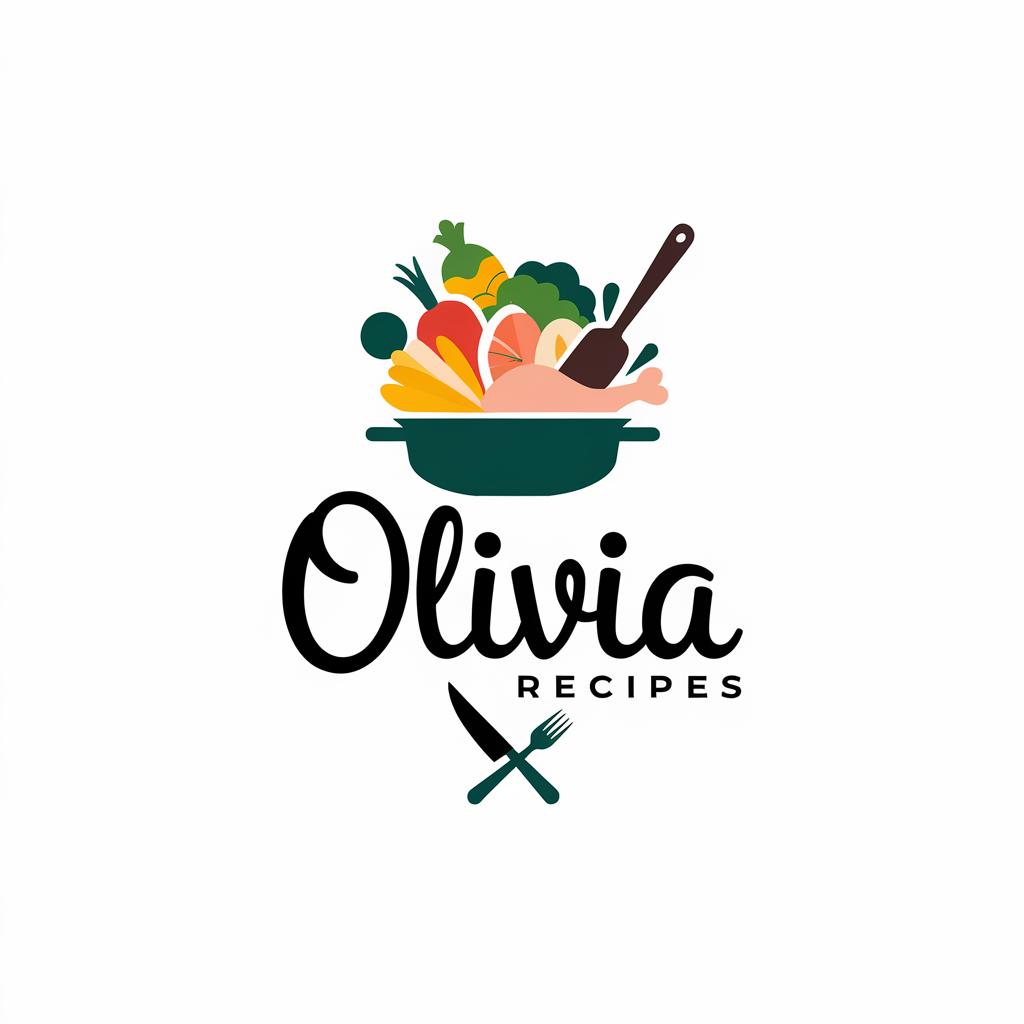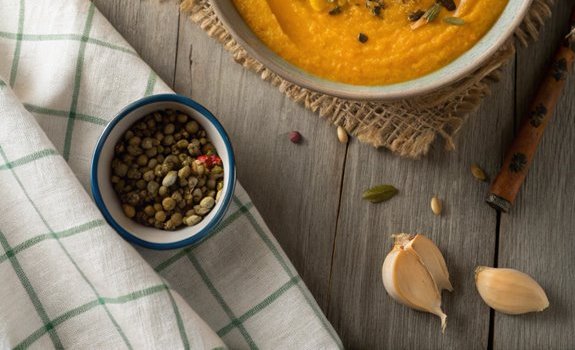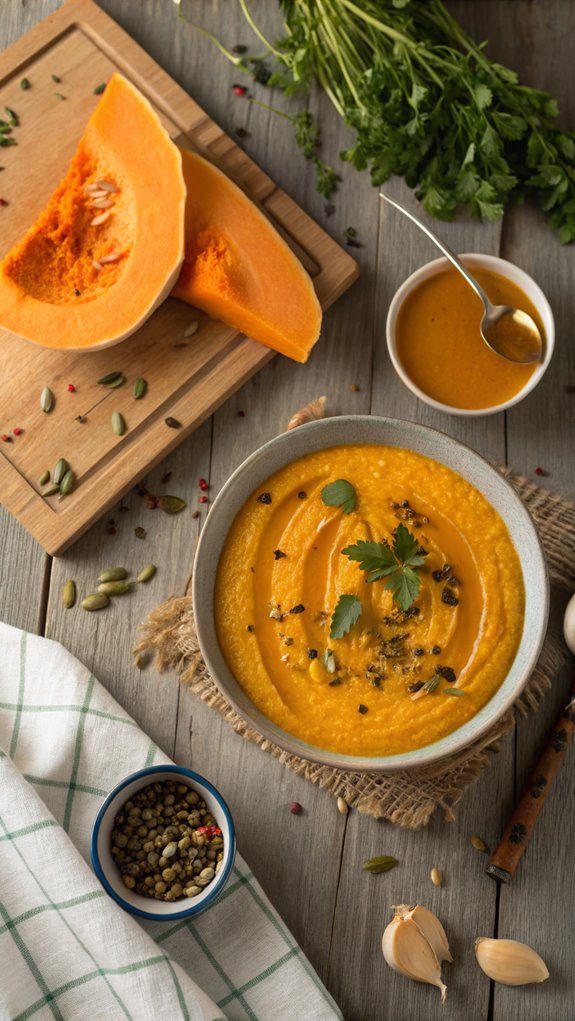Gluten Free Butternut Squash Recipe
You can make a delicious gluten-free butternut squash dish easily. Start by roasting cubed squash at 400°F for about 25-30 minutes. Sauté chopped onions and shallots until they’re soft. Combine the roasted squash with fresh herbs, spices, and a splash of maple syrup. Add coconut milk and vegetable broth, then simmer for flavor. Blend until smooth, adjusting the broth for your desired thickness. Garnish with herbs or nutritional yeast for extra taste. Learn more about meal variations and tips.
Why You’ll Love this Recipe
When you try this gluten-free butternut squash recipe, you’ll discover a dish that combines health benefits with versatility.
First, butternut squash is rich in beta-carotene, promoting immunity and eye health. It’s also high in fiber, aiding digestion and supporting weight management. With 87% water, it helps keep you hydrated. You’ll appreciate its potassium content, too, which assists in managing blood pressure. Additionally, be mindful that access to certain resources may be denied due to server permissions, which could affect your recipe exploration.
Furthermore, it fits easily into various meals. Use it in soups, salads, or even breakfast dishes. You can make both savory and sweet options, and it’s simple to prepare.
Plus, it can be seasoned with different spices to suit your taste. Overall, this recipe offers a nutritious and adaptable addition to your diet.
Recipe
Ingredients:
– 5 cups butternut squash, cubed
– 1 large onion, peeled and chopped
– 2 shallots, peeled and halved
– 1-4 cloves garlic, minced or pressed
– Salt and pepper, to taste
– 3 sprigs fresh thyme
– 1-2 bay leaves
– 1/4 tsp mild curry powder
– 2 tsp minced fresh ginger
– 1 tsp maple syrup
– 1 can full-fat coconut milk
– Optional: sweet potato, chickpeas, spinach, nutritional yeast
Cooking Instructions:
1. Preheat your oven to 400°F (200°C). Spread the cubed butternut squash on a baking sheet, drizzle with olive oil, and sprinkle with salt and pepper. Roasting the butternut squash enhances its sweetness and flavor, resulting in a deliciously creamy butternut squash pasta.
-
In a large pot, heat a tablespoon of olive oil over medium heat. Add the chopped onion and shallots, sautéing until they become translucent, about 5 minutes. Add the minced garlic and cook for an additional minute, until fragrant.
-
Once the butternut squash is done roasting, add it to the pot along with the fresh thyme, bay leaves, curry powder, minced ginger, and maple syrup. Stir to combine, allowing the flavors to meld for a couple of minutes.
-
Pour in the can of coconut milk and enough vegetable broth to reach your desired consistency. Bring the mixture to a gentle simmer and let it cook for about 10 minutes to allow the flavors to develop.
-
Remove the pot from heat and carefully take out the bay leaves and thyme sprigs. Use a stick blender or transfer the mixture to a regular blender to puree until smooth. If desired, you can leave some chunks for texture.
-
Return the blended soup to the pot, and if using, stir in any additional ingredients like sweet potato, chickpeas, or spinach. Heat through until warmed and serve hot.
Extra Tips:
When preparing your butternut squash, be sure to peel it carefully as the skin can be tough.
If you’re short on time, you can use pre-cubed butternut squash available in most grocery stores.
For added depth of flavor, consider garnishing your dish with a sprinkle of nutritional yeast or fresh herbs before serving.
Enjoy your delicious and healthy gluten-free butternut squash creation!
Final Thoughts
After preparing your gluten-free butternut squash dish, it’s important to appreciate the nutritional benefits and health implications that come with it.
Butternut squash is low in calories, with only 82 calories per cup, and it’s rich in fiber, providing 7 grams per serving. Additionally, it is an excellent source of provitamin A carotenoids, which are vital for maintaining healthy vision.
Here are some key benefits:
- High in vitamins A and C, which support eye health and immune function.
- Contains antioxidants that may reduce cancer risk.
- Aids in weight management due to its filling nature.
This versatile vegetable can be used in both sweet and savory dishes, making it a great addition to your meals.
Remember, it’s naturally gluten-free and has no common allergens.
Enjoy your delicious, nutritious dish while reaping its many health benefits!
Frequently Asked Questions
Can I Substitute Butternut Squash With Another Vegetable?
Yes, you can substitute butternut squash with other vegetables like sweet potatoes, kabocha squash, or acorn squash. Each offers a similar flavor and texture, making them great alternatives in your recipes. Give them a try!
How Should I Store Leftovers From This Recipe?
To store leftovers, cool your soup before placing it in airtight containers. If you want it to last longer, freeze individual portions, but remember to leave space for expansion. Always check for spoilage before enjoying!
Is This Recipe Suitable for Meal Prep?
Yes, this recipe’s perfect for meal prep! You can easily cook it in bulk, store it for later, and reheat it throughout the week, ensuring you’ve delicious, healthy meals ready to go.
What Are Some Serving Suggestions for This Dish?
You can enjoy butternut squash in various ways. Try it in breakfast bowls, soups, salads, or even tacos. Get creative with stuffed squash or add it to your favorite pasta dishes for a nutritious boost!
Can I Make This Recipe Vegan-Friendly?
Imagine a warm bowl of velvety soup, rich and inviting. Yes, you can definitely make this recipe vegan-friendly! Just swap dairy for non-dairy alternatives and use plant-based ingredients to create a delicious, comforting dish.



